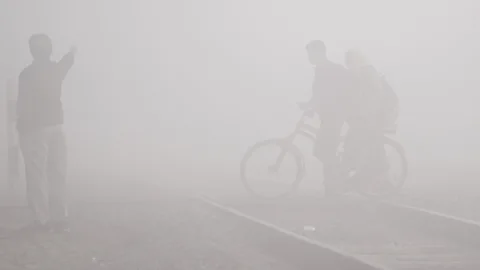Why the world feels so unstable right now
 Geoffroy Van der Hasselt/Getty Images
Geoffroy Van der Hasselt/Getty ImagesOur lives tend to run smoothly and predictably most of the time, but they are also prone to intermittent instability with devastating consequences. Can we do more to predict these periods and even intervene to prevent them?
For many of us, life seems to progress smoothly and predictably for much of the time. Indeed, it seems one of our biggest concerns appears to be getting stuck in a rut. But then, seemingly out of nowhere, our world is turned upside down. A global pandemic strikes us down, killing millions of people and forcing entire countries into lockdown. Then inflation takes off and economic downturn threatens our livelihoods. And (not unrelated) one country invades another and the resulting war affects us all. Whoa! Where on Earth did all that come from?
Comment & Analysis
Tim Palmer a Royal Society Research Professor in climate physics at the University of Oxford. His book The Primacy of Doubt (Oxford University Press and Basic Books), describes the science of uncertainty across a range of fundamental and applied sciences.
There's a generic reason for these sudden unforeseen catastrophes. It's something commonly found in many "nonlinear systems" in the physical, biological and social sciences: intermittent instability. That is to say, after long periods of boring and predictable behaviour, these systems suddenly become wildly unpredictable, exhibiting extreme fluctuations.
What is a nonlinear system? It's one whose outputs are not in direct proportion to inputs. We humans are nonlinear systems: if we win $1m (or £1m if you prefer) in the lottery, we will likely be very happy indeed. But if we were to win $4m/£4m, we would likely not be four times as happy. Put more viscerally, if doubling our wealth in the lottery would make us happy, losing our wealth through some stupid gamble would not just make us sad, it would devastate us.
Nonlinearity is a key ingredient behind the phenomenon of chaos – the process underpinning the famous butterfly effect – how a small uncertainty can grow and make the whole system unpredictable. However, in chaotic systems, the butterfly effect is not fully at play all the time. Sometimes a chaotic system can be predictable for quite a long period into the future. On other occasions, near an intermittent instability, the flap of a butterfly's wings can destroy predictability over a very short period of time. It's all a consequence of nonlinearity.
 Brendan Smialowski/AFPGetty Images
Brendan Smialowski/AFPGetty ImagesThe weather is a nonlinear chaotic system. It's rather boring and predictable for most of the time but occasionally becomes wildly unpredictable and extreme. In October 1987, BBC weather forecaster Michael Fish told viewers not to worry about strong winds that turned out to be the worst storm southern England had experienced in 300 years, just the day before it happened. Meteorologists learned from this experience. It was realised that the evolution of what has become known in some circles as the "Fish storm" was exceptionally sensitive to the butterfly effect – much more so than normal. And so, nowadays, when trying to predict the weather, forecast centres run ensembles of 50 simulations, each differing slightly in their initial conditions (by flaps of meteorological butterfly wings).
When the atmosphere is very unstable, as it was in October 1987, then the assorted forecasts within the ensemble will differ dramatically from one another: some will show hurricane-strength extreme weather, others will show much more benign weather. All a forecaster can do in such a situation is estimate some probability, or likelihood, that the extreme event will occur.
But forecasting a significant probability for an extreme event is much better than forecasting nothing significant, as happened in 1987. And ensemble weather prediction is today revolutionising the way humanitarian and disaster relief agencies send emergency food, shelter, medicine and even finance to regions at risk of extreme weather. Such anticipatory action is taken when the ensemble-based probabilities for extreme weather exceed a pre-determined threshold.
Can we humans influence the likelihood of such intermittent instabilities? Yes, we can.
By continuing to emit greenhouse gases into the atmosphere, thus warming and moistening the air, we are tilting our nonlinear climate system towards greater intermittent instability. Perhaps one of the most devastating types of instability is associated with a tipping point, for example associated with the disintegration of a large ice sheet, leading to significant sea-level rise. In this situation, we cannot undo the damage caused by simply reversing our emissions; that would be locking the stable door after the horse has bolted.
We have the ability to decrease the likelihood of these climatological instabilities by regulating the emission of greenhouse gases. But which actions will be the most effective?
To guide these decisions, climate scientists try to model the climate system and estimate how climate will change as a result of different conceivable future emissions scenarios. But there are uncertainties in these estimates, not least arising from the effect of these emissions on internal atmospheric processes like cloud cover.
Climate scientists try to take account of these uncertainties by running ensembles of climate models where, say, uncertain cloud processes are represented in different possible ways. It is vitally important that our ensembles provide reliable probabilities of damaging climate change. My own view is that we have more to do on the latter and should indeed be pooling our resources internationally to create a new type of "Cern for climate change" – an intergovernmental research organisation that will focus on climate science rather than particle physics as Cern does.
Even our solar system, often thought of as the most clockwork and predictable system of them all, is chaotic and can exhibit intermittent instability.
 Himanshu Sharma/Getty Images
Himanshu Sharma/Getty ImagesHow to think about X
This series will change the way you look at the world. Whether it's the concept of "time", "consumerism", or even "creativity", many of us tend to think about – and define – certain ideas in the ways we've been taught. But how did our conceptualisation of these big ideas evolve? How to Think About X searches for new ideas about our lives, the concepts that govern them and our future.
Over a hundred years ago, the French physicist Henri Poincaré showed that there was nothing in principle stopping the planets from being ejected very suddenly from the Solar System. Fortunately, based on ensemble forecasts of the solar system, we can be confident that this type of intermittent instability will not happen in the foreseeable future (in this case many millions of years).
However, a mini version of this instability is much more likely: that a small asteroid will be unpredictably ejected from the asteroid belt and will hit Earth with effects similar to one or more nuclear bombs. For this reason, Nasa is improving its near-term asteroid prediction capabilities and is designing the means of diverting rogue asteroids if they do suddenly head for Earth. The Dart mission, where a spacecraft was crashed into the asteroid Dimorphos, successfully tested our ability to deal with the intermittent instabilities of the asteroid belt by changing the course of a space rock that could be Earth-bound. In this case, we have the means to partially control the instabilities and prevent their worst effects.
Could we prevent the occurrence of individual weather events, like the 1987 storm that struck England or the hurricanes that annually plague the east coast of the US, by similar types of intervention? In the 1950s, an idea was mooted to explode nuclear bombs in suitably targeted parts of the atmosphere, to move hurricanes away from their predicted paths if they threatened populated regions. However, notwithstanding the obvious problem of radioactive fallout, the weather is much too complex to be able to do this type of weather control reliably.
To have any chance of affecting a severe weather system, the explosion would have to be done many days in advance, before the system had become mature. Estimating where to explode the bomb at this range depends very sensitively on the small-scale details of the forecast atmospheric circulation patterns – get the estimated position for explosion wrong by even few kilometres and the bomb may have little impact on the targeted extreme weather system. Our ability to calculate these sensitive locations, at a forecast range where the technique might in principle work, is just not that good. It's an interesting idea – but (fortunately perhaps) is unlikely to work reliably in practice.
But extreme weather is not the only non-linear system to be affecting our lives recently.
The spread of Covid-19 was not especially well predicted in the early phases of the disease. However, it spurred the development of epidemiological models for predicting death and hospitalisation arising from Covid infection. As with climate change, these are not so much predictions, as projections: estimates predicated on different policy options, from strict lockdowns to no response at all. However, although the earlier disease models were not themselves especially reliable, as more models with different assumptions were developed, so multi-model ensembles of Covid hospitalisations and deaths became possible by pooling the model outputs together in probabilistic form. These gave much more reliable estimates of plausible worst-case scenarios than could ever be provided by single-model predictions.
The global economy is another nonlinear system that can have a profound influence on all our lives. According to the former Bank of England's chief economist, Andy Haldane, the economists had their Michael Fish moment in 2008 when Queen Elizabeth II famously asked an assembly of economists in the City of London why they hadn't seen the financial crash of that year coming. Haldane realised that the type of economic model used by the Bank of England was simply unable to represent the type of intermittent instability that can occur in the financial system.
It's relatively easy to describe the conditions where an intermittent financial instability might occur qualitatively. Most of the time a hedge fund damps volatility in the price of a stock by moving the stock towards its intrinsic worth. However, the banks lend the hedge funds money, and to contain their risk, the banks limit the amount they are prepared to lend.
Now suppose a stock's value falls when the hedge fund is fully leveraged. The hedge fund will have to sell its stock to pay off part of the loan. But selling the stock in this way can cause the stock to fall further in value. This makes it even harder for the hedge fund to pay back the loan. Perhaps not only the hedge fund, but also the bank will go broke if this behaviour is widespread. In this way, a sort of death-spiral instability for the whole economy is set in motion, especially if that economy is dependent on the health of its financial sector.
 Yulii Zozulia/Getty Images
Yulii Zozulia/Getty ImagesThe problem is that traditional neo-classical models of the macroeconomy simply do not include such microscale processes. A new type of model – an agent-based model – seeks to do this. Here the model attempts to integrate the action of individual agents, such as businesses, industries, banks and hedge funds, from the ground up.
The philosophy underpinning such models is not much different to a weather forecast model where the individual agents are small grid squares (of a few kilometres in horizontal scale) describing weather variables on some assumed elemental scale. The mathematics of agent-based models is messy, unlike the elegant but less useful mathematics of neo-classical economic models. But that's the way the world can be – rather messy.
You might also like to read:
Ensemble prediction methods based on agent-based models are being developed to predict probabilistically intermittent instabilities in the financial sector. However, compared with weather and climate prediction, these developments are at a very early stage.
And of course, our ability to predict the economy does depend on whether the world is at peace or at war. One of the pioneers of quantitative weather prediction, Lewis Fry Richardson, also developed some of the first quantitative conflict prediction models. Conflict prediction is also starting to develop into a mature field using agent-based models, and again ensemble prediction techniques, where key uncertainties are varied across ensemble members, is vital to produce reliable probabilistic predictions. These models did highlight the Ukraine as a potential hot spot for conflict, ahead of Russia's invasion.
Let's put all this together. Intermittent instabilities are a feature of many nonlinear systems in nature and in global society. On the whole their impacts appear to be profoundly negative, disrupting our lives in a bad way. How can we deal with these instabilities? Perhaps we can stop them happening at all. In the case of a rogue asteroid, this indeed seems possible. In the case of weather or indeed the economy, the systems are too complex for this to be feasible. However, for the latter examples, we can make the occurrence of intermittent instabilities less likely even if we cannot eliminate them altogether, such as by regulating the emissions of greenhouse gases on the one hand, or by regulating financial transactions in highly leveraged situations on the other. We can also try to take precautionary actions to mitigate the impacts of instabilities when they are predicted.
However, by their nature, these instabilities are difficult to predict and can depend sensitively on uncertain parts of the system. To reliably predict the occurrence of instabilities, ensemble prediction systems must be developed where individual ensemble members differ in the representation of the uncertain parts of the system. The result is not a deterministic but a probabilistic forecast of the instability.
Whether it is worth taking precautionary action in the light of such a forecast will then depend on the cost of action, the unmitigated damage caused by the instability, and on the forecast probability of occurrence of the event. If the first is small enough, or the last two large enough, then it will be worth it. (Read more about the tricks you can use to navigate uncertainty.)
Ensemble prediction has become a fairly mature field in weather and climate prediction, has accelerated in disease modelling due to Covid-19, and is slowly evolving as a field in economics and conflict prediction, due to the development of agent-based models.
Perhaps in future years, the "Whoa! Where did that come from?" reaction as another intermittent instability hits us from one of a number of different possible directions, may be heard less often.
* Tim Palmer is a professor of climate physics at the University of Oxford and pioneered the development of probabilistic ensemble forecasting techniques for weather and climate prediction.
--
